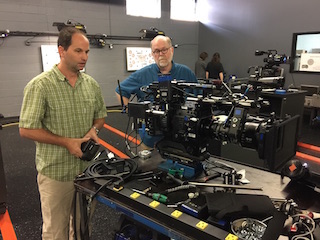 The upcoming dramatic series Containment, slated for a mid-season premiere on the CW Television Network, follows an epidemic that breaks out in Atlanta, leaving the large city quarantined and those stuck on the inside fighting for their lives. The series was shot by co-directors of photography William Wages ASC and John Smith with four VariCam 35 4K camera/recorders.
The upcoming dramatic series Containment, slated for a mid-season premiere on the CW Television Network, follows an epidemic that breaks out in Atlanta, leaving the large city quarantined and those stuck on the inside fighting for their lives. The series was shot by co-directors of photography William Wages ASC and John Smith with four VariCam 35 4K camera/recorders.
Hired to shoot six of twelve season one episodes, DPs Wages and Smith each pitched the VariCam 35 to series executive producer Julie Plec.
Wages' work in television includes the final season of Revolution, three seasons of Burn Notice, and the Spielberg-produced mini-series Into the West. He has won three ASC awards and been nominated for six additional ASC awards and two Emmy awards. Smith is known for his work on Alias, Brothers and Sisters and Revenge.
"The VariCam 35 has excellent dynamic range," Wages said. "Coupling that with the dual native ISOs of 800 and 5000 makes it the ideal camera for a series that has a lot of night exteriors. What's more, the VariCam 35's color science is exceptionally filmic."
“I like the way the VariCam 35's super 35mm sensor looks,” Smith added. “The flesh tones feel film-like, with beautiful roll off of the highlights. Also, with the VariCam 35 you get native 4K shooting, and I admire its modular design, the ability to split the camera/recorder in half.”
 Containment was shot last summer and autumn on sets and practical locations in Atlanta. The production rented four VariCam 35s from the Atlanta office of SIM Digital; its Bling Digital division provides post-production services to the series. A and B cameras were predominantly used hand-held; a third VariCam 35 was dedicated to Steadicam work, and the fourth was used for second units and back up. The cameras were outfitted with Fujinon 19-90mm and 85-300 zoom lenses, and 14mm and 16mm Primes.
Containment was shot last summer and autumn on sets and practical locations in Atlanta. The production rented four VariCam 35s from the Atlanta office of SIM Digital; its Bling Digital division provides post-production services to the series. A and B cameras were predominantly used hand-held; a third VariCam 35 was dedicated to Steadicam work, and the fourth was used for second units and back up. The cameras were outfitted with Fujinon 19-90mm and 85-300 zoom lenses, and 14mm and 16mm Primes.
The main acquisition format was Apple ProRes 4444, used with Panasonic's V-Log curve, which maximizes the VariCam 35's expansive dynamic range. The production also utilized the Lumix GH4 updated with V-Log L curve for select 4K shooting.
Both DPs said that the ISO5000 setting was intrinsic to the production. "We shot ISO5000 all the time, almost every day,” Wages noted. "We were able to drastically cut our studio lighting package. For example, we lit a 120-foot by 20-foot day backdrop with only 19 2K fixtures, and in most scenes had to dim it down because it was too bright."
“The VariCam 35's internal ND filters are fantastic,” Smith said. “Also, we took advantage of the ability to load LUTs into the monitoring channels. And the camera is as rugged as promised: we worked in sweltering conditions in Atlanta, 100 degrees, 95 percent humidity, with excellent performance.”
“The VariCam 35's latitude is such that I find you use only a tenth of the light you need with other cameras: a huge time-saver,” Wages said. “The camera renders tonalities more smoothly than other cameras, ably handling our broad range of skin tones and shaving years off the actors.”
“The VariCam 35 is at the top-tier of production cameras,” Smith added. “It fits beautifully in that elite category, and represents 'another color on the palette' for cinematographers.”
William Wages http://www.williamwages.com
John Smith http://www.johnsmithimages.com
